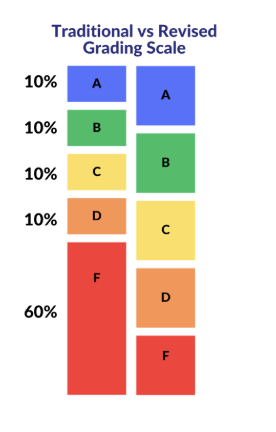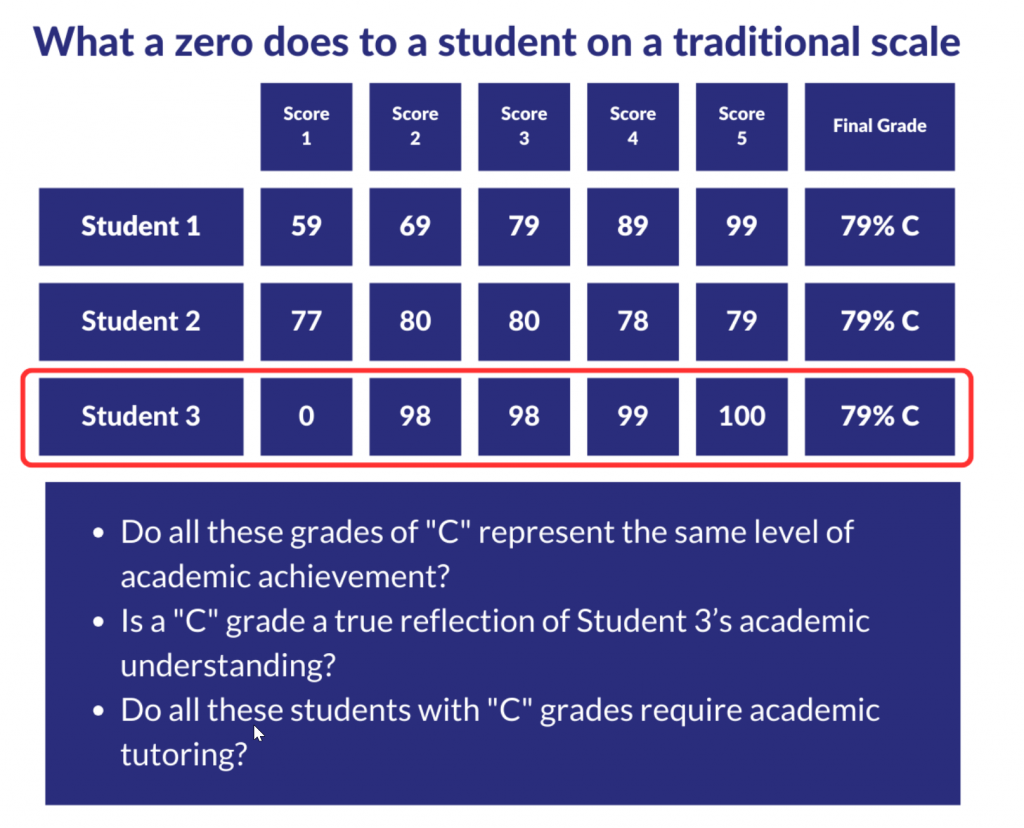The Governing Board believes that grades serve a valuable instructional purpose by helping students and parents/guardians understand performance expectations and identifying the student’s areas of strength and areas needing improvement. Parents/guardians and students have the right to receive course grades that accurately evaluate the student’s academic performance.
San Leandro Unified School District has established a comprehensive grading policy to ensure fair and accurate evaluation of student achievement. Adopted on December 6, 2016, and last revised on August 3, 2022, Policy 5121 and Regulation 5121 mandate that grades reflect students’ knowledge and skills in the content area, excluding nonacademic factors.
- Grades are based on the most recent demonstrations of knowledge, and reassessments or revisions of graded assignments are allowed.
- Grades do not include non academic factors such as behavior, attendance, work habits. Those are reported under citizenship and work habits sections of the report card.
- In order to ensure an accurate representation of learning, each letter grade interval shall be equivalent.
Report cards are distributed at the end of each grading period, either online or in print. Parents are encouraged to discuss grades and strategies for improvement with teachers. If a student is at risk of failing, teachers must notify parents through a conference or written report.
For grades TK-5, student progress is reported as:
- 4: Standard Exceeded
- 3: Standard Met
- 2: Standard Nearly Met
- 1: Standard Not Met
For grades 6-12, academic performance is reported as:
- A: Mastery of Standards
- B: Proficient on Standards
- C: Approaching Proficiency on Standards
- D: Beginning Proficiency on Standards
- F: Little or No Progress on Standards
- I: Incomplete
An Incomplete is given when a student’s work is unfinished due to illness or excused absence. The student has six weeks to complete the work before it turns into an F.
Physical education grades are based on individual progress and performance, not on wearing standardized apparel. Students in interscholastic athletics can fulfill PE requirements under the supervision of a credentialed teacher.
Background
In 2015, San Leandro Unified School District began annual teacher training to address concerns about grade accuracy, inconsistent pass/fail rates, and the lack of formal instruction on grading systems in credential programs.
In 2016, responding to teacher and parent feedback, the district revised its policy to allow teachers to give an Incomplete instead of an F. This gave students up to six weeks to make up missed work and improve their grades.
In 2021, the district further updated the policy to ensure an F had equal weight as other grades, preventing the disproportionate impact of failing grades and ensuring grades represent mastery of academic standards.
Grading Policy Resources
- How Teachers are Changing Grading Practices with an Eye on Equity – KQED
- Does Grading Undermine Your Equity Initiatives? – Leadership
Joe Feldman: Grading for Equity, Corwin: 2019.
Harvard Graduate School of Education: “Grading for Equity.”


Source: Feldman, J. (2023). Grading for equity: What it is, why it matters, and how it can transform schools and classrooms. Corwin Press.
In February 2021, San Leandro Unified School District presented an update on Grading for Equity and Policy Change. The presentation, available from minute 39 of the meeting, details a 20-minute discussion.
The district then adjusted its approach based on teacher feedback, requiring grades to have “equal intervals,” allowing flexibility with various grading systems. From 2016 to 2019, training was department-by-department, but the pandemic shifted this to small groups and coaching cycles. Some teachers missed training due to turnover or opting out.
In 2023-24, principals requested teachers to submit their syllabi for review to ensure alignment with board policy and to plan support. For 2024-2025, the district will continue teacher training and gather feedback for future policy updates. Sessions for families will also be held to explain the policies. Family input, emphasizing the need for consistent grading, is reflected in the Local Control and Accountability Plan (LCAP) through LCAP Parent Advisory Committee (PAC) and District English Language Advisory Committee (DELAC) meetings.
Traditional Grading Practices
- Behavior is not separated from academic progress.
Grades include a mix of factors such as timeliness, completion of class and homework assignments, participation, effort, creativity, and bringing materials to class, along with assessments of understanding. All of these factors are combined into one letter grade, and progress by standard is not communicated.
Criteria for success might not be provided, and the grading is one-sided (teacher-to-student with no discussion).
There are 60 degrees of failure in a 100-point range. One zero significantly drops the grade without redemption opportunities.
Grades include every score, regardless of when collected or the purpose of the assignment. Final grades record the average of all of these assignments, including early attempts at learning and natural mistake-making practice.
There is no incentive to keep learning, as retaking an assessment is prohibited.
Equitable Grading Practices
Transition to standards-based grading with clear success criteria to more clearly communicate academic progress.
Separate academic grades from behavioral assessments to ensure fair evaluation of student knowledge.
Even grade intervals mitigate the mathematical inaccuracies caused by a zero. A missed assessment will still impact the grade significantly, but not disproportionately.
Prioritize summative assessments over formative assessments to better reflect final student learning and encourage academic risk-taking and the natural process of mistakes during the learning process.
Students are encouraged to continue learning and then reassess a standard to show their progress. Assessments include multiple means of demonstrating understanding and skill.
Timeline
- Administrator Training & Board Policy 5121 revision
- Teacher training cohorts with Crescendo
- Grading for Equity book and online course is launched with instructional coaches facilitating the teacher cohorts.
- The pandemic disrupted training sessions, but some San Leandro High School departments continued group work, and books were ordered for interested individuals.
- Mini-Administrator Training & Board Administrative Regulation (AR) Revision
- Three new teacher training cohorts were established. Additionally, some middle and high school departments focused on alignment efforts.
- Aeries and Schoology systems are configured to align with Administrative Regulation (AR) standards. This alignment ensures consistency and compliance with district policies in managing student information and educational resources.
Frequently Asked Questions
No. Work that meets the standard is graded as an A, while work that does not meet the standard can still receive an F. Traditionally, schools use an A, B, C, D, F grading scale, which is a 5-point scale. Administrative regulation (5121) on reporting student achievement requires equal grade intervals to avoid overweighting the F grade. Overweighting occurs when an A represents 90-100%, B is 80-89%, C is 70-79%, D is 60-69%, and F is 0-59%. This makes the F grade disproportionately large compared to other grades. The policy ensures each grade has the same point spread. Teachers have discretion on how to assign grades within equal intervals, including using a 5-point scale or rubrics/narratives.
This is incorrect. If students submit work after an absence, it should be accepted and graded. The policy does not require grading lower-level work higher. Late work is graded based on quality: exemplary work receives a high grade, adequate work receives a corresponding grade, and work not meeting standards is graded accordingly. Lateness due to absence does not prevent grading. Commentary on lateness can be noted in the work habits section. The purpose of this provision is to ensure that grades reflect mastery of the content, not the ability to submit work on time. This provision has been part of the policies before our revisions.
The policy states: “Teachers shall not include indicators of work habits or behavior such as lateness to class or in submission of work, bringing materials to class, perceived effort, attendance, classroom conduct and the like (these may be reported under ‘work habits’ or ‘citizenship’). Additionally, to honor the learning process and continued motivation to learn, students shall be allowed to reassess a standard or revise a graded assignment within a reasonable timeframe.” What a reasonable timeframe is can be determined by the teacher along as students have multiple opportunities to demonstrate their learning.
No. Colleges have always had to contend with differences in grading policies across districts, there has not been a national alignment of grading standards across public schools. By making final grades more accurately reflect mastery of academic standards, grades will reflect more accurately what each student knows and is able to do in each subject area.
No, the policy was updated in 2016 and again in 2021 after working with teachers to address feedback from families about inconsistent grading. Most changes align with the California Education Code, ensuring grades reflect academic mastery and student learning. Equal grade band intervals and grading based on content mastery, not behavior, have been in place since 2016. The district continues to ensure accurate and transparent reporting on student achievement and provides ongoing teacher training.
- Alameda USD
- Castro Valley USD is doing professional development to move to a proportional scale (50-100 or 0-4).
- Berkeley Unified: Uses a 4-point to ensure equal grade bands that follow equitable grading practices.
- Alcalanes Joint Union High School: In their LCAP as an action item
- San Francisco USD (0-4 scale)
- Placer Union High School District
- San Diego USD (min 50%)
- Los Angeles USD

